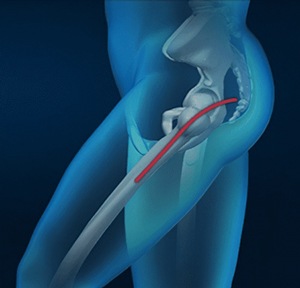What is Posterior Hip Replacement Surgery?
Posterior hip replacement is a surgical procedure in which the worn out or damaged surfaces of the hip joint are removed and replaced with artificial joint components made of metal, ceramic, and plastic. The posterior approach is traditionally the most common approach used to perform a total hip replacement. In a posterior hip replacement, the surgeon makes the hip incision at the side of the hip close to the buttocks to gain access to the backside (posterior) aspect of the hip joint to perform the replacement. The incision is placed so the abductor muscles, the major walking muscles, are not cut.

Posterior Hip Replacement Procedure
- Posterior hip replacement surgery is performed under general anesthesia or regional anesthesia. During the procedure, you will lie on your side in a lateral position.
- A surgical cut is made along the side of the hip to expose the hip joint and the femur is dislocated from the acetabulum.
- The surface of the socket is cleaned and the damaged or arthritic bone is removed using a reamer. The acetabular cup component is inserted into the socket in a press fit manner, or occasionally using screws or bone cement. A liner made of plastic, is placed inside the acetabular component and serves as a smooth gliding surface.
- The femur or thighbone is prepared by removing the arthritic femoral head portion and preparing the femoral canal to accept a metal femoral component. This femoral component is then inserted into the femur either by a press fit or using bone cement. Then, the femoral head ball component made of ceramic is placed on the femoral stem. Both sides of the hip joint with the new components are put in their proper positions together. The entire joint is then irrigated and cleaned with a sterile solution. The incision is carefully closed and a sterile dressing is placed over the incision.
Risks and Complications of Posterior Hip Replacement
All surgeries and various approaches to the hip carry an element of risk, whether it is related to the anesthesia or the procedure itself. Risks and complications with posterior hip replacement are rare, but can occur and may include:
- Dislocation
- Leg length inequality
- Infection at the incision site or joint space
- Fracture of the femur or pelvis
- Injury to nerves or blood vessels
- Formation of blood clots in the leg veins
- Wearing out of the hip prosthesis
- Failure to relieve pain
- Loosening of the implant
Advantages of Posterior Hip Replacement
The advantages of posterior hip replacement include:
- Less likely to have intraoperative fractures
- Less likely to have skin incision healing issues
- Allows excellent visibility of the joint
- More extensile approach


